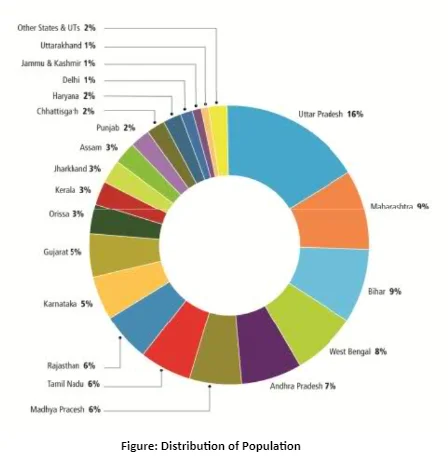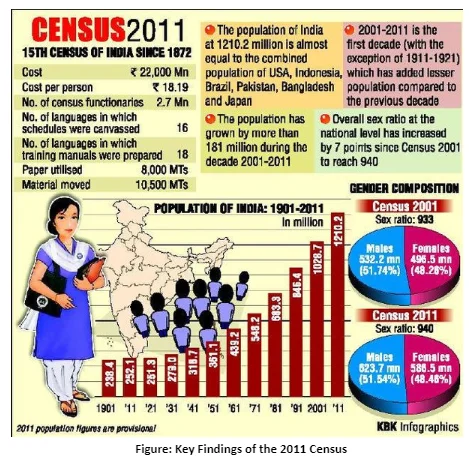The Census of India is a count of all the people living in the country that happens every ten years. The first census was conducted in 1872, with the first complete census taking place in 1881. Since then, the census has been done every ten years. This important process helps us understand how the population of India changes over time and provides essential information for planning and policymaking.
Overview of India’s Census: Insights into Population, Urbanization, and Development”
- Total Population: As of March 2011, India’s population reached 1,210.6 million, comprising 17.5% of the global population.
- The population of India is distributed unevenly across the country’s vast land area of 3.28 million square km, representing 2.4% of the world’s total area.

- Population Distribution
- 31.165 % of the total population can be categorised as urban.
- Goa is the most urbanised state (62% urban population)
- Himachal Pradesh has the highest percentage of rural population.
- Union territory with the least population: Lakshadweep
- Union Territory with the highest population: Delhi
- State with the highest population: Uttar Pradesh> Maharashtra> Bihar
- State with the lowest population: Sikkim
- Density of population
- State with highest population density: Bihar
- State with the lowest population density: Arunachal Pradesh
- Union Territory with highest population density: Delhi
- Union Territory with the lowest population density: Andaman and Nicobar
- Sex Ratio
- Sex ratio: 943 females per 1000 males
- State with the highest sex ratio: Kerala
- State with the lowest sex ratio: Haryana

- Literacy
- Literacy Rate in India: Males-82.14%; Females-65.46%; Overall Literacy-74%
- State with the highest literacy rate: Kerala
- State with the lowest literacy rate: Bihar
Glossary of Demographic Terms
| Terms |
Definition |
| Crude Birth Rate |
- Annual number of live births per 1,000 people.
|
| General Fertility Rate |
- Annual number of live births per 1,000 women of childbearing age ( from 15 to 49 years)
|
| Crude Death Rate |
- Annual number of deaths per 1,000 people
|
| Infant Mortality Rate |
- Annual number of deaths of children of age less than 1 year old per 1,000 live births.
|
| Life Expectancy |
- number of years which an individual at a given age can expect to live at present mortality levels.
- Life expectancy in India is 69.16 years (2017).
|
| Total Fertility Rate |
- Expected number of live births per woman during her reproductive life.
|
| Gross Reproduction Rate |
- An average number of daughters a woman would have if she survived all of her childbearing years, subject to the age-specific fertility rate and sex ratio at birth throughout that period.
|
| Maternal Mortality Rate (MMR) |
- Number of maternal deaths per 100,000 live births.
|
| Sex Ratio |
- Number of females per thousand males. India: 940 (2011 Census)
|
| Child Sex Ratio |
- Number of females per thousand males in the age group of 0–6 years.
- India: 914 (2011 Census)
|
| Child Mortality Rate |
- Number of child deaths under the age of 5 per 1000 live births.
|
| Dependency Ratio |
- The ratio of the number of dependents aged zero to 14 and over the age of 65 to the total population aged 15 to 64.
|
| Demographic Window |
- Period of time in demographic evolution when the proportion of the population of the working age group is particularly prominent.
|
| Demographic Dividend |
- Economic growth potential is due to shifts in a population’s age structure, mainly when the share of the working-age population (15 to 64) is larger than the non-working-age share of the population (14 and younger, and 65 and older).
|
Conclusion
- The Census of India 2011 highlights significant variations in population distribution, urbanization rates, literacy levels, and sex ratios among states and union territories.
- Understanding these demographic dynamics is crucial for effective policymaking and planning to address the diverse needs of India’s population and harness its demographic dividend for sustainable development.
![]() May 2, 2024
May 2, 2024
![]() 11177
11177
![]() 0
0

